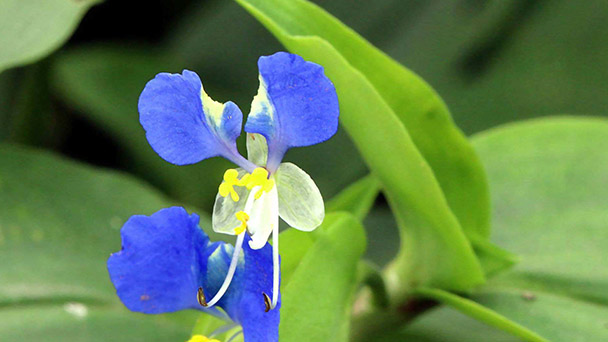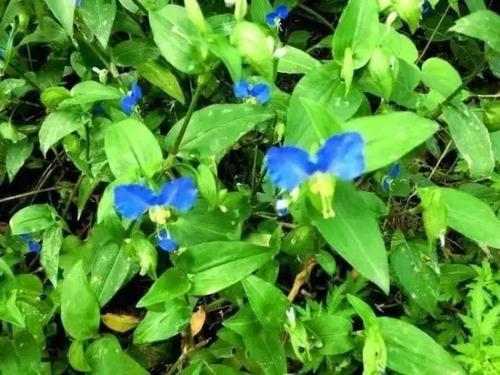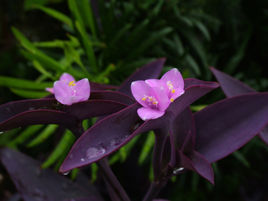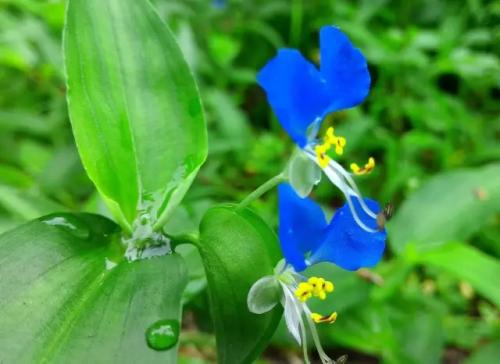Commelina communis profile
Written by Maggie
Nov 24 2020

The leaves of Commelina communis are lanceolate to ovate-lanceolate. The leaf order is alternate, the stem is stoloniferous, the flowers are terminal or axillary, monoecious, the upper two petals are blue, the lower one is white, the bud is fovo-flame bract, green, and the stamens have 6. Commelina Communis is born in Yunnan, Sichuan and Gansu to the east. It is also distributed in Vietnam, North Korea, Japan, the Russian Far East and North America, from which the model specimens were collected.
Commelina Communis picture

Morphological characteristics of Commelina Communis
Commelina Communis are annual scattered herbs. Stems are prostate rooting, much branched, up to 1 m long, glabrous at lower, glabrous at upper. Leaves are lanceolate to ovate-lanceolate, 3-9 cm long, 1.5-2 cm wide.
Involucral bracts are bract, 1.5-4 cm stalked, opposite to leaves, folded, cordate when spread, apically short and acute, basally cordate, 1.2-2.5 cm long, margin often bristly. Cymes, lower one with only one flower, with 8 mm stalk, infertile. Above one with 3-4 flowers, with a short stalk, hardly extending the tlame bud. Pedicels are only 3 mm long, fruit curved, not more than 6 mm long. Sepals are membranous, ca. 5 mm, inner 2 often closed or conated. Petals are dark blue. It has two inner surfaces with claws, nearly 1 cm long.
Capsule is elliptic, 5-7 mm long, 2-loculate, 2-valves, 4-seeded.Seeds 2-3 mm long, brownish yellow, one end truncate, ventral plain, with irregular fossa.
Commelina Communis growth habit
Commelina Communis are commonly found in wetlands. It is adaptable and can grow in full light or half shade. But it can not overcast, otherwise the leaf color declines to light pink green. Commelina Communis likes warm and humid climate, weak light and avoid sunshine exposure. The optimal growth temperature is 20~30℃, and the temperature at night is 10~18℃, which is not less than 10℃ in winter.
Commelina Communis has no strict requirements on the soil. With strong drought resistance, the soil can grow if it is a little wet. If the soil is too wet for a long time, it is prone to stem and leaf decay.

Use of Commelina Communis
1. Greening effect
Commelina Communis is an excellent indoor leaf-viewing plant that can be placed in a few shelves on the windowsill or in an outdoor shade. Commelina Communis can effectively remove harmful indoor gases, release oxygen, and is an excellent plant for indoor air purification.
2. Medicinal effects
Function and indications: line of water, heat, cold blood, detoxification, edema, beriberi, difficulty in urination, cold, erythema, mumps, jaundice hepatitis, heat dysentery, malaria, blood in the urine, blood blowout, white neck, sore throat, ulcer or ulcer.
Performance: sweet, slightly bitter, . It can clear heat, detoxify, diuretic. It is a good medicine for reducing swelling, diuresis, clearing away heat and detoxifying. In addition, it has a good curative effect on sty, pharyngitis, tonsillitis, cervical erosion and abdominal snake bite. Pharmacological action: the water infusion or decoction of the stem and leaves of the same genus can excite the uterus, constrict the blood vessels, and shorten the clotting time.
Prevention and treatment of colds of Commelina Communis
Take two slices of Commelina communis grass (2 ~ 4 slices of fresh grass), and fry them in water twice.130 cases were treated, 109 cases were effective (body temperature decreased to normal within 1 ~ 3 days), 21 cases were not effective (fever decreased over 4 days).Take tablets (each tablet contains 10.3g of dried raw medicine), 3 times a day, 2 tablets each time;
Treatment of mumps complicated with meningoencephalitis
Commelina Communis grass 2 twigs a day, Fried.The average duration of antipyretic and parotid swelling was 2.8 days, headache disappeared for 1.4 days, vomiting ceased for 1.2 days, and the average length of hospitalization was 4.6 days.

Treatment of sty
1 shot (or 1 segment) of fresh Commelina Communis stem was taken and burned on the upper segment at a 45-degree Angle by hand, indicating that the foaming liquid was boiling in the lower segment. Then, the boiling liquid was dripped onto the conjunctiva and palpebral margin (the local swelling and the surrounding area of sty). The surface of the face could also be coated hot.
Latest Updated
- Benefits of Bugleweed - 7 Science-backed Health Benefits
- Bugleweed Dangers & Side Effects - Is It Poisonous?
- How to Plant Evergreen Trees - What You Should Know
- When to Plant Evergreens - Grow Guide for Evergreen Trees
- 12 Wonderful Evergreen Shrubs for Your Garden
- 12 Popular Evergreen Plants with Pictures for Beginners
- When And How To Prune A Lilac Bush Like a Pro
- How to Grow & Care for Lilac Vine (Hardenbergia Violacea)
- Japanese Lilac Tree (Syringa Reticulata) Care & Propagation Guide
- Shumard Oak Pros and Cons - What to Know
Popular Articles
- Winter maintenance of Antirrhinum Majus
- How to Grow Terminalia Mantaly Tree
- How to Grow and Care for Crossostephium Chinense
- How to grow Antirrhinum Majus in spring
- Peristeria Elata (Dove Orchid) Profile: Info & Care Guide
- Underwatered Snake Plant (Sansevieria Trifasciata) - Signs And How To Fix
- How to Care for Brazilian Jasmine Plant (Mandevilla Sanderi)
- How to Grow & Care for Graptopetalum Purple Delight in Summer
- Rosa Chinensis (China Rose): Plant Growing & Care Tips
- How to Care for Baby Sun Rose (Aptenia Cordifolia)